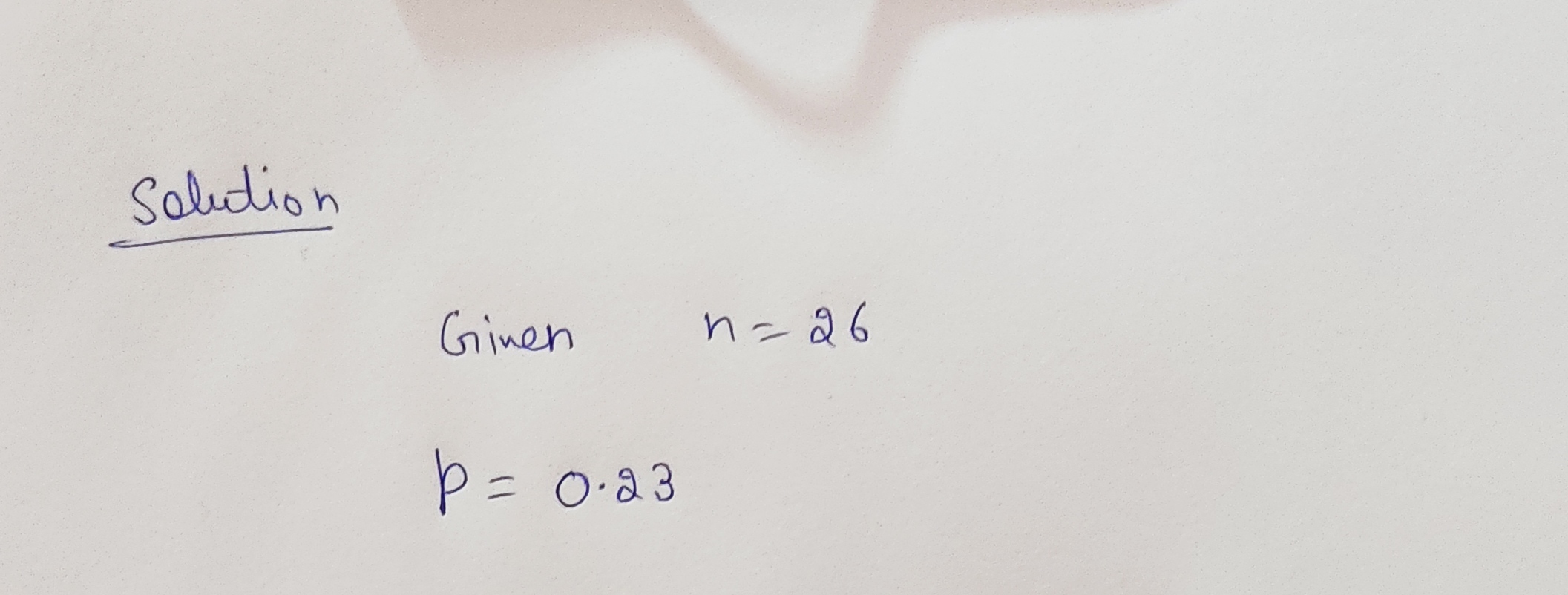(a) Suppose n = 26 and p = 0.23. (For each answer, enter a number. Use 2 decimal places.) n·p = n·q = ? Can we approximate p̂ by a normal distribution? Why? (Fill in the blank. There are four answer blanks. A blank is represented by _____.)
(a) Suppose n = 26 and p = 0.23. (For each answer, enter a number. Use 2 decimal places.) n·p = n·q = ? Can we approximate p̂ by a normal distribution? Why? (Fill in the blank. There are four answer blanks. A blank is represented by _____.)
MATLAB: An Introduction with Applications
6th Edition
ISBN:9781119256830
Author:Amos Gilat
Publisher:Amos Gilat
Chapter1: Starting With Matlab
Section: Chapter Questions
Problem 1P
Related questions
Question
(a)
- Suppose n = 26 and
- p = 0.23.
n·p =
n·q = ?
Can we approximate p̂ by a
_____, p̂ _____ be approximated by a normal random variable because _____ _____.
first blank
YesNo
cancannot
both n·p and n·q exceedn·q exceeds n·p and n·q do not exceedn·q does not exceedn·p exceedsn·p does not exceed
?
What are the values of ?p̂ and ?p̂? (For each answer, enter a number. Use 3 decimal places.)
?p̂ = mu sub p hat =
?p̂ = sigma sub p hat =
(b)
Suppose- n = 25 and
- p = 0.15.
_____, p̂ _____ be approximated by a normal random variable because _____ _____.
first blank
YesNo
cancannot
both n·p and n·q exceedn·q exceeds n·p and n·q do not exceedn·q does not exceedn·p exceedsn·p does not exceed
?
n·p =
n·q = ?
Can we approximate p̂ by a normal distribution? Why? (Fill in the blank. There are four answer blanks. A blank is represented by _____.)
_____, p̂ _____ be approximated by a normal random variable because _____ _____.
first blank
second blank
third blank
fourth blank (Enter an exact number.)
(c)
Suppose- n = 48 and
- p = 0.35.
n·p =
n·q = ?
Can we approximate p̂ by a normal distribution? Why? (Fill in the blank. There are four answer blanks. A blank is represented by _____.)
_____, p̂ _____ be approximated by a normal random variable because _____ _____.
first blank
YesNo
cancannot
both n·p and n·q exceedn·q exceeds n·p and n·q do not exceedn·q does not exceedn·p exceedsn·p does not exceed
?
What are the values of ?p̂ and ?p̂? (For each answer, enter a number. Use 3 decimal places.)
?p̂ = mu sub p hat =
?p̂ = sigma sub p hat =
What are the values of ?p̂ and ?p̂? (For each answer, enter a number. Use 3 decimal places.)
?p̂ = mu sub p hat =
?p̂ = sigma sub p hat =
Expert Solution
Step 1
NOTE: As per the guidelines, we are supposed to solve the first question only. Please repost other questions are separate ones.

Trending now
This is a popular solution!
Step by step
Solved in 2 steps with 2 images

Recommended textbooks for you

MATLAB: An Introduction with Applications
Statistics
ISBN:
9781119256830
Author:
Amos Gilat
Publisher:
John Wiley & Sons Inc

Probability and Statistics for Engineering and th…
Statistics
ISBN:
9781305251809
Author:
Jay L. Devore
Publisher:
Cengage Learning

Statistics for The Behavioral Sciences (MindTap C…
Statistics
ISBN:
9781305504912
Author:
Frederick J Gravetter, Larry B. Wallnau
Publisher:
Cengage Learning

MATLAB: An Introduction with Applications
Statistics
ISBN:
9781119256830
Author:
Amos Gilat
Publisher:
John Wiley & Sons Inc

Probability and Statistics for Engineering and th…
Statistics
ISBN:
9781305251809
Author:
Jay L. Devore
Publisher:
Cengage Learning

Statistics for The Behavioral Sciences (MindTap C…
Statistics
ISBN:
9781305504912
Author:
Frederick J Gravetter, Larry B. Wallnau
Publisher:
Cengage Learning

Elementary Statistics: Picturing the World (7th E…
Statistics
ISBN:
9780134683416
Author:
Ron Larson, Betsy Farber
Publisher:
PEARSON

The Basic Practice of Statistics
Statistics
ISBN:
9781319042578
Author:
David S. Moore, William I. Notz, Michael A. Fligner
Publisher:
W. H. Freeman

Introduction to the Practice of Statistics
Statistics
ISBN:
9781319013387
Author:
David S. Moore, George P. McCabe, Bruce A. Craig
Publisher:
W. H. Freeman